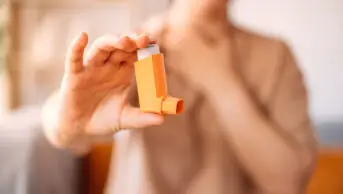
BNMK0819 / Shutterstock.com
Pharmacies in areas with high rates of hospital visits for asthma dispensed fewer preventive medicines compared with reliever drugs, US research has found, indicating that promoting the role of pharmacy in managing asthma treatment could reduce the number of deaths from the condition.
In the retrospective study, data on asthma medicines dispensed by a chain of 27 pharmacies were mapped against data on the number of children who visited the emergency department or were hospitalised for asthma at Cincinnati Children’s Hospital Medical Center between January 2010 and January 2012.
A pharmacy-level asthma medication ratio (Ph-AMR) was calculated for each pharmacy by looking at the number of preventer asthma medicines dispensed divided by the summed total of preventer plus reliever medicines dispensed. For instance, a Ph-AMR ratio of 1 would indicate that only preventive (controller) asthma medicines had been dispensed and no reliever (or rescue) medicines.
Researchers analysed the circumstances around 35,467 dispensed asthma medicines (18,842 controller and 16,625 rescue), 554 asthma-related emergency visits and 203 hospitalisations, involving children aged 2–17 years across 27 city centre and suburban pharmacies in Hamilton County, in southwest Ohio. Their findings were published in Pediatrics
[1]
on 4 May 2015.
The researchers calculated that a 0.1 increase in the Ph-AMR ratio was associated with a reduction of 9.5 emergency events per 1,000 child-years. The median Ph-AMR was 0.53 (range 0.38–0.66) and there were an average of 22.4 emergency events per 1,000 child years (range 1.3–60.9).
Pharmacies with low Ph-AMRs were in areas that had emergency event rates four times those of pharmacies with high Ph-AMR, the researchers say.
“If the relationship is causal, improved Ph-AMR rates and associated use of proven controller therapies would substantially reduce asthma morbidity and its associated cost,” the researchers believe, concluding that pharmacies could be a “community-based leverage point for improving population-level asthma control”.
Expanding on the implications of the study, the researchers note that pharmacists offer consistent patient interaction and the ability to track prescription data over time. They say “collaborative relationships between physicians and community pharmacists could enhance asthma therapies and improve outcomes for those at highest risk”. They also argue that such monitoring could be used to identify better ways of delivering proactive, rather than reactive, asthma care.
These conclusions provide timely support for the Pharmacy and Medically Underserved Areas Enhancement Act currently going through US Congress. The HR592 bill aims to guarantee patient access to Medicare Part B services provided by pharmacists in communities underserved by the healthcare system, in areas such as medication management, chronic disease management and preventive diagnostic testing.
The Act is seen by Thomas Menighan, executive vice president and chief executive of the American Pharmacists Association, as a “critical legislative fix that would allow millions of Americans access to the quality services of pharmacists”.


